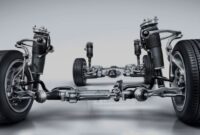Next-Gen Materials: Carbon Fiber and Aluminum in Automotive Engineering
Introduction
The automotive industry has been continuously evolving, driven by the demand for safer, more efficient, and environmentally friendly vehicles. One of the most critical areas of advancement is the use of next-generation materials that redefine the engineering and performance capabilities of modern vehicles. Among these materials, carbon fiber and aluminum have emerged as game-changers, revolutionizing automotive design, manufacturing, and functionality.
This article explores in detail the role of carbon fiber and aluminum in automotive engineering, their unique properties, manufacturing techniques, advantages, challenges, real-world applications, and future outlooks. Understanding these materials is key to appreciating how modern vehicles achieve the delicate balance between strength, weight, safety, and sustainability.
1. The Need for Next-Gen Materials in Automotive Engineering
1.1 Challenges with Traditional Materials
For decades, steel has been the dominant material in vehicle construction, thanks to its strength, durability, and cost-effectiveness. However, traditional steel faces significant challenges:
• Weight: Steel is heavy, contributing to greater fuel consumption and higher emissions.
• Performance Limits: Increasing vehicle safety and efficiency demands materials with better strength-to-weight ratios.
• Environmental Impact: Steel production is energy-intensive and generates significant CO₂ emissions.
1.2 Industry Drivers
Modern automotive engineering seeks to overcome these challenges by focusing on:
• Weight Reduction: Lighter vehicles consume less fuel or energy and emit fewer pollutants.
• Safety Enhancement: Materials must absorb impact energy efficiently without compromising structural integrity.
• Sustainability: Reducing environmental impact from raw material extraction to vehicle end-of-life.
• Performance: Better materials allow for higher speeds, better handling, and longer durability.
Carbon fiber and aluminum stand out because they directly address these critical needs.
2. Aluminum in Automotive Engineering
2.1 Overview of Aluminum Properties
Aluminum is a lightweight, silvery-white metal known for:
• Low density: About one-third the weight of steel.
• Good corrosion resistance: Forms a protective oxide layer.
• Excellent thermal and electrical conductivity.
• High strength-to-weight ratio (especially when alloyed).
These properties make aluminum ideal for automotive parts requiring both strength and lightness.
2.2 Manufacturing Processes
Automotive-grade aluminum is often used in forms such as castings, extrusions, and sheets, manufactured via:
• Casting: Molten aluminum poured into molds to form engine blocks, cylinder heads, and suspension parts.
• Extrusion: Aluminum is forced through shaped dies, used for body frames and structural supports.
• Sheet Metal Stamping: For body panels like doors, hoods, and roof panels.
• Forging: For critical components requiring high strength.
2.3 Advantages of Aluminum
• Weight Reduction: Can reduce vehicle weight by up to 30% compared to steel.
• Improved Fuel Efficiency: Lower weight improves miles per gallon (MPG) or electric vehicle (EV) range.
• Better Crash Performance: Aluminum can absorb and dissipate energy effectively in crashes.
• Recyclability: Aluminum is highly recyclable with minimal loss of quality, making it environmentally friendly.
2.4 Challenges with Aluminum
• Cost: More expensive than steel due to raw material and processing costs.
• Joining Techniques: Requires specialized welding and bonding methods because it does not weld like steel.
• Repair Complexity: Aluminum repairs often need specific tools and training.
• Fatigue Resistance: Aluminum can be more susceptible to fatigue cracking if not properly engineered.
2.5 Applications in Vehicles
• Body and Chassis: Many modern vehicles, including the Ford F-150 and Audi A8, use aluminum extensively for body panels and frames.
• Engine Components: Cylinder heads, blocks, and intake manifolds are commonly aluminum to reduce weight.
• Suspension and Wheels: Aluminum alloys provide strength with less mass, improving handling.
• Heat Exchangers: Radiators and condensers utilize aluminum for superior thermal conductivity.
3. Carbon Fiber in Automotive Engineering
3.1 Overview of Carbon Fiber Properties
Carbon fiber is a composite material composed of carbon filaments embedded in a resin matrix. Key properties include:
• Exceptional strength-to-weight ratio: Stronger than steel but much lighter.
• High stiffness: Resistant to deformation.
• Corrosion resistance: Does not rust or corrode.
• Thermal stability: Maintains properties over a wide temperature range.
• Fatigue resistance: Excellent durability under cyclic loads.
3.2 Manufacturing Techniques
Carbon fiber parts are created through complex processes:
• Prepreg Layup: Layers of carbon fiber fabric impregnated with resin are hand-laid or automated in molds.
• Resin Transfer Molding (RTM): Resin is injected into a mold containing dry carbon fiber fabrics.
• Autoclave Curing: Components are cured under heat and pressure to improve strength.
• Additive Manufacturing (Emerging): 3D printing carbon fiber composites for complex parts.
3.3 Advantages of Carbon Fiber
• Extreme Weight Savings: Up to 50-70% lighter than steel, and 30-50% lighter than aluminum.
• High Strength and Rigidity: Allows thinner, lighter parts without sacrificing performance.
• Design Flexibility: Can be molded into complex shapes difficult with metals.
• Corrosion and Fatigue Resistance: Longer lifespan in harsh environments.
3.4 Challenges of Carbon Fiber
• High Cost: Raw materials and labor-intensive manufacturing result in high prices.
• Repair Difficulty: Damage requires specialized repair techniques or full part replacement.
• Brittleness: While strong, carbon fiber can fail suddenly rather than bending.
• Recycling Issues: Complex to recycle compared to metals.
3.5 Applications in Vehicles
• Supercars and Sports Cars: Brands like Lamborghini, Ferrari, and McLaren use carbon fiber extensively for body panels and chassis.
• Structural Components: Safety cells and crash structures benefit from carbon fiber’s energy absorption.
• Interior Trim: Lightweight dashboards, seats, and door panels.
• Electric Vehicles: Battery enclosures and motor mounts use carbon fiber for weight savings.
4. Comparative Analysis: Carbon Fiber vs Aluminum
Property Carbon Fiber Aluminum
Density (g/cm³) ~1.6 ~2.7
Tensile Strength (MPa) 3,500–6,000 200–600 (alloys vary)
Modulus of Elasticity (GPa) 230–600 70
Cost per kg Very High Moderate
Corrosion Resistance Excellent Excellent
Repairability Difficult Moderate
Recyclability Challenging Easy
Summary:
• Carbon fiber offers unmatched strength-to-weight but at a high cost and complexity.
• Aluminum provides excellent balance between cost, weight, strength, and ease of manufacturing.
• Automotive applications often blend both materials depending on performance, cost targets, and manufacturing constraints.
5. Hybrid Material Strategies
Automakers increasingly combine carbon fiber and aluminum to capitalize on their complementary advantages:
• Aluminum frames with carbon fiber panels to reduce weight while controlling costs.
• Carbon fiber reinforced aluminum parts to improve stiffness and impact resistance.
• Multi-material vehicle architectures blending steel, aluminum, carbon fiber, and plastics to optimize each part’s function.
Examples include:
• BMW i Series: Carbon fiber reinforced plastic (CFRP) passenger cell with aluminum chassis.
• Audi R8: Carbon fiber monocoque with aluminum subframes.
• Ford Mustang Shelby GT500: Aluminum hood and carbon fiber roof.
6. Environmental Impact and Sustainability
6.1 Aluminum
• Recycling: Aluminum is one of the most recycled materials worldwide. Recycling saves 95% of the energy compared to primary production.
• Life Cycle: Aluminum vehicles can have a smaller carbon footprint due to weight savings improving fuel efficiency.
• Challenges: Mining bauxite for aluminum extraction causes environmental concerns including deforestation and water pollution.
6.2 Carbon Fiber
• Current Challenges: Carbon fiber recycling remains difficult, often ending in landfills or incineration.
• Research: Developing chemical and mechanical recycling processes to recover fibers.
• Future Potential: Recycled carbon fibers could reduce environmental impact and cost.
6.3 Regulatory Pressure
Governments worldwide are pushing for lightweight, efficient vehicles to meet stringent emission targets, accelerating the adoption of next-gen materials.
7. Future Outlook and Innovations
7.1 Advances in Aluminum Technology
• Ultra-high-strength aluminum alloys being developed for improved crash performance.
• Additive manufacturing of aluminum components for customized and lightweight parts.
• Improved joining methods like friction stir welding enabling complex assemblies.
7.2 Innovations in Carbon Fiber
• Faster manufacturing techniques reducing production time and cost.
• Hybrid composites combining carbon fiber with other fibers (glass, aramid) for balanced properties.
• Smart composites embedded with sensors for structural health monitoring.
• Recyclable thermoplastic carbon fiber composites replacing traditional thermosets.
7.3 Material Informatics
Use of AI and machine learning to design new alloys and composites tailored for automotive needs.
7.4 Integration with Electric Vehicles
Lightweight materials are critical in EVs to maximize battery range and performance. Carbon fiber and aluminum will continue to be pivotal in the EV revolution.
8. Case Studies
8.1 BMW i3
One of the first mass-produced cars to feature a carbon fiber reinforced plastic (CFRP) passenger cell combined with an aluminum chassis. This design reduced weight by 250 kg compared to a steel equivalent, improving EV range and handling.
8.2 Ford F-150
Ford’s switch to an aluminum-intensive body in 2015 resulted in a 700-pound weight reduction, improving fuel economy and payload capacity while maintaining toughness.
8.3 McLaren P1
A supercar that uses a carbon fiber monocoque chassis to achieve incredible rigidity and weight savings, resulting in breathtaking performance and safety.
9. Challenges Ahead
• Cost Reduction: Both materials remain expensive compared to traditional steel.
• Manufacturing Scale: Scaling carbon fiber production to mass-market volumes remains a hurdle.
• Training and Repair Infrastructure: Mechanics and body shops need training for these materials.
• Design Complexity: Multi-material design requires sophisticated engineering tools and software.
Conclusion
The adoption of carbon fiber and aluminum represents a paradigm shift in automotive engineering. These next-generation materials enable significant weight reduction, enhanced safety, and better environmental performance, critical for the future of mobility.
While challenges remain, ongoing innovations in manufacturing, recycling, and material science continue to drive costs down and broaden applications. The future of automotive design will likely see a greater fusion of these materials, pushing the limits of what vehicles can achieve in performance, safety, and sustainability.
For automakers and consumers alike, carbon fiber and aluminum symbolize not just the materials of the future—but the very essence of modern automotive innovation.



